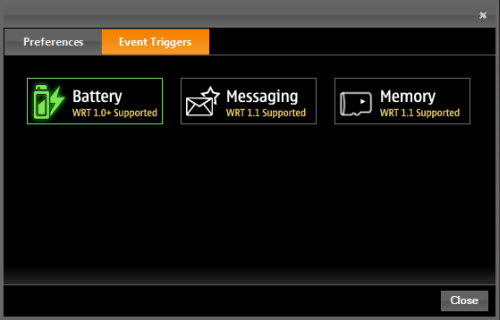The two new plug-ins (or rather an extension in the case of Adobe Dreamweaver) offer more or less the same functionality as the first version of the Aptana plug-in. So there are features to create, import, edit, preview, debug, validate, package, and deploy widgets. There are a few variations in the functionality available in each plug-in, for example the Visual Studio version allows widgets to be imported from a widget package, while the Dreamweaver extension does not, there is a feature to insert snippets of code based on the WRTKit library in Dreamweaver, and both plug-ins include a feature to deploy to a file (which is not available in Aptana).
The updated Aptana Studio plug-in is a step ahead of the new plug-ins, offering the ability to preview and debug widgets that include with the WRT 1.1 API (and therefore the S60 Platform Services integration APIs) and home screen mini views. All the indications are that the other plug-ins will get these features in a future release.
The final release of the Aptana plug-in contains some additional features compared to the beta release made available in April. The extra features include the ability to issues triggers to a previewed widget for battery, memory and messaging events as well as a JavaScript console and updated documentation.
Putting the WRT 1.1 API support and minor feature variations aside, the plug-ins all work in basically the same way. They are all quite easy to use and appear to integrate well with their host tools, so should be readily accepted by existing users of Dreamweaver and Visual Studio.
One aspect of this release that is likely to stir up some ‘feedback’ is the support for Visual Studio. Forum Nokia withdrew Carbide.vs, which provided support to Symbian C++ developers in Visual Studio, back in January. The withdrawal displeased a number of developers. The official reason for the withdrawal was that the fully featured version of Carbide.c++ had become available free of charge. Some developers may see the same argument applying here; Aptana Studio offers developers a free environment in which widgets can be developed. It will be interesting to see if the release of the WRT plug-in for Visual Studio stirs up much debate.
Nokia is placing an ever greater emphasis on alternative development options for S60 these days, as part of its overall cross-platform development strategy. These new releases should certainly help broaden the developer community creating WRT widgets. WRT widgets will probably displace more traditional development options for applications that rely on information sourced from the web. These tools should certainly help accelerate that transition.
Nokia updates, extends WRT widget tools
Published by Richard Bloor at
Forum Nokia has announced an update to the plug-in that enables WRT widget development in Aptana Studio and added new plug-ins for Adobe Dreamweaver and Microsoft Visual Studio. WRT widgets are clearly seen by Nokia as a mechanism to accelerate the availability of add-on features for S60 devices. Recent news, such as the availability of a Facebook widget, suggests it may be a good strategy.
